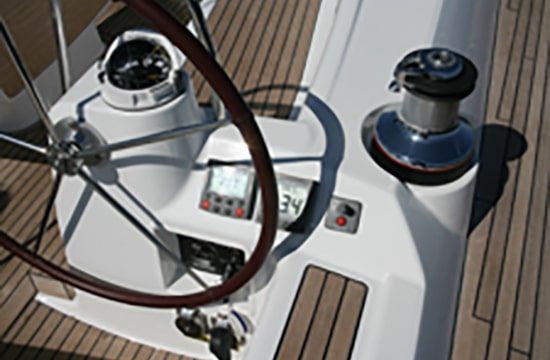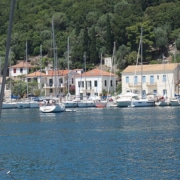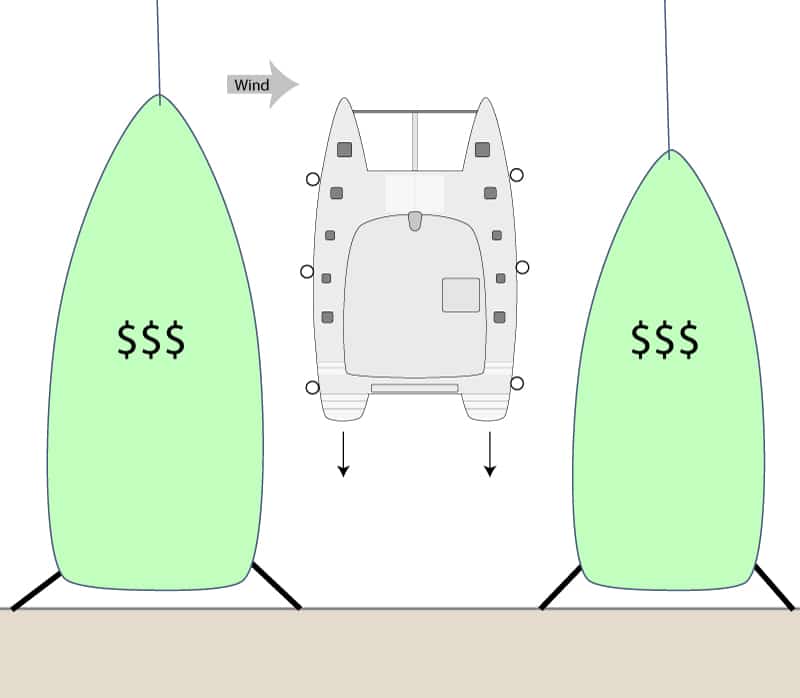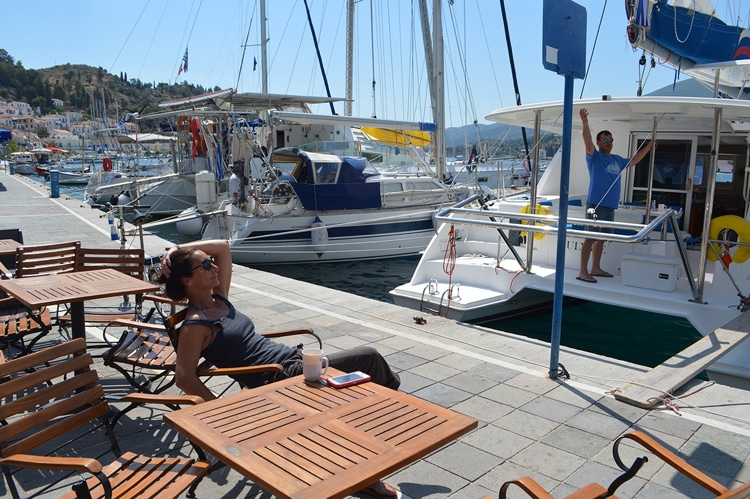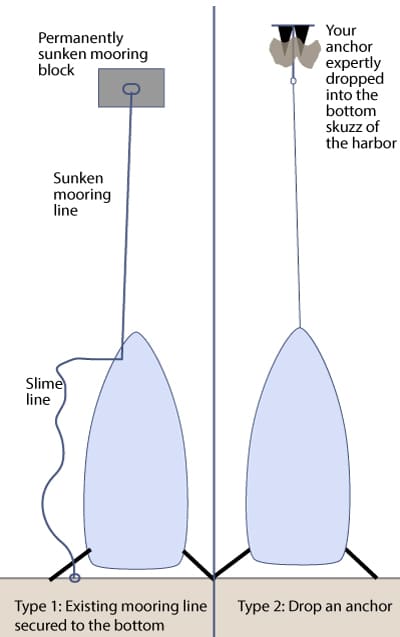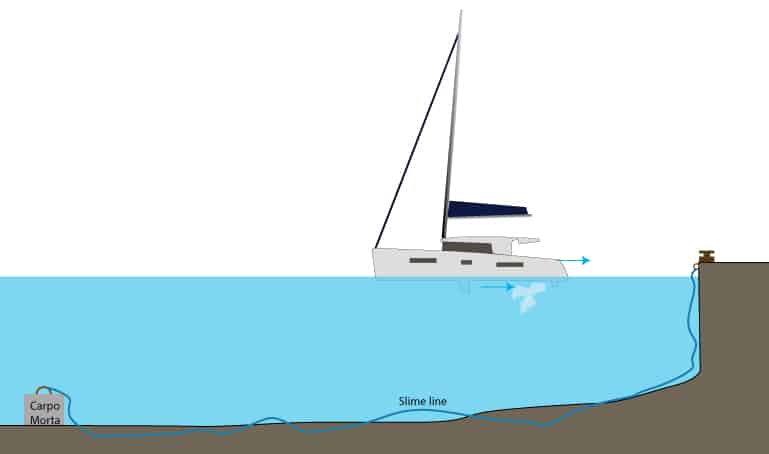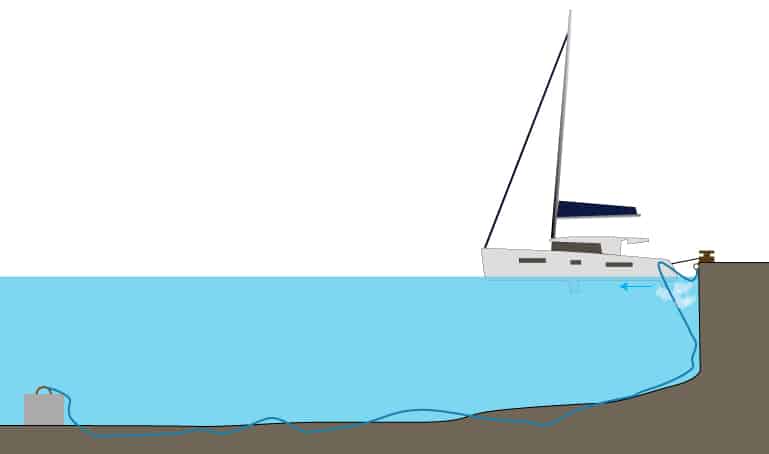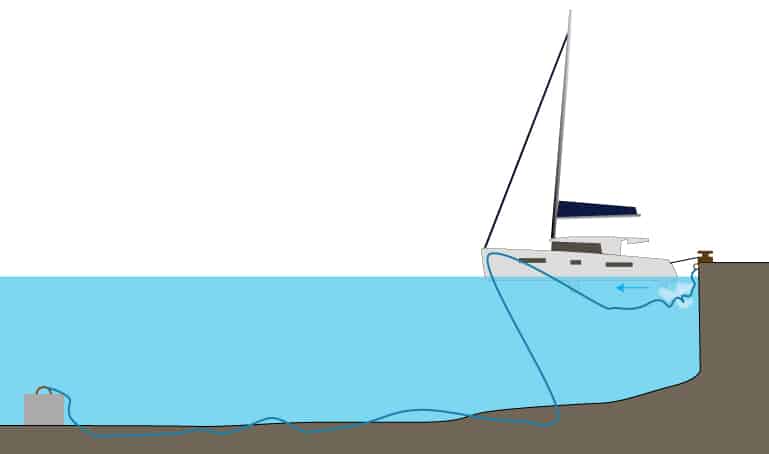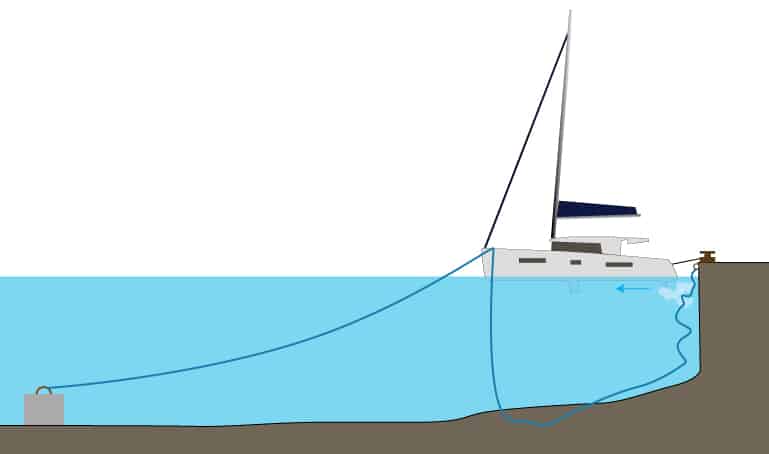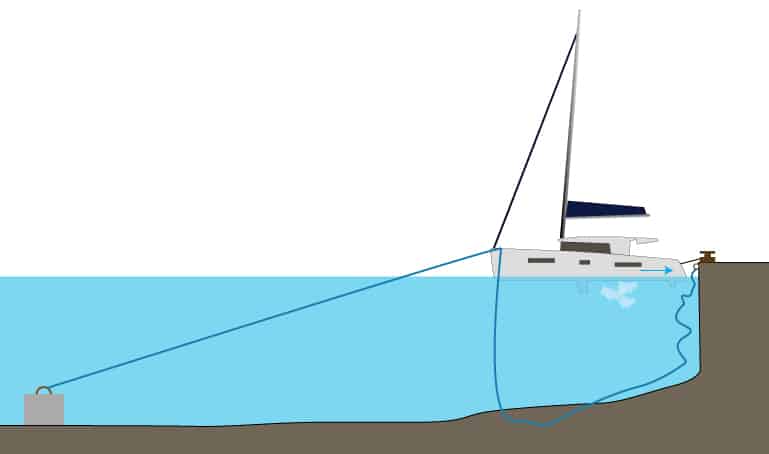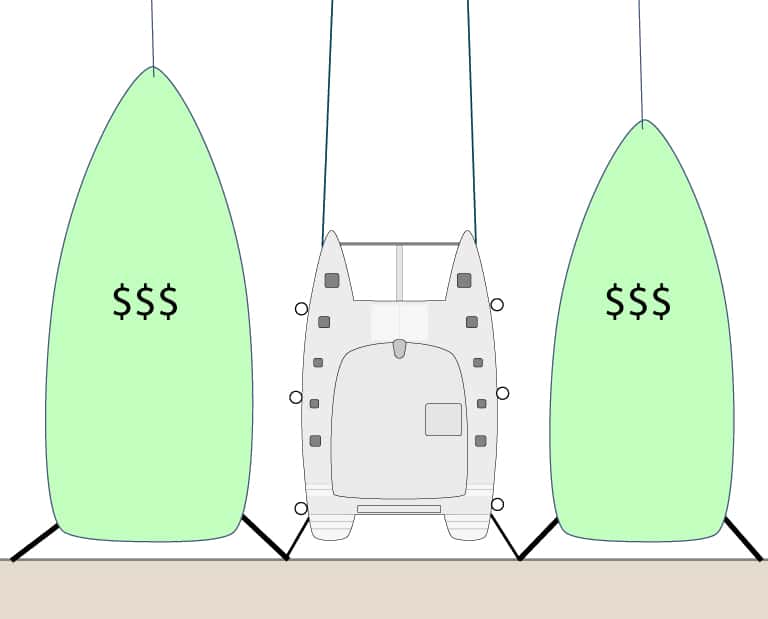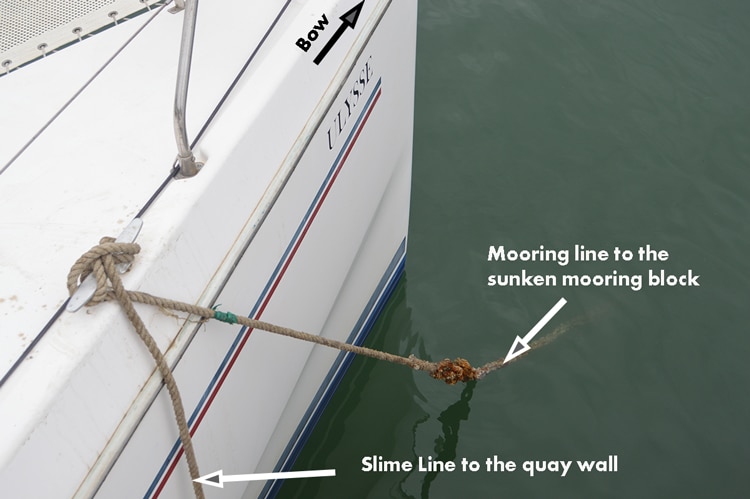Mediterranean Mooring Techniques
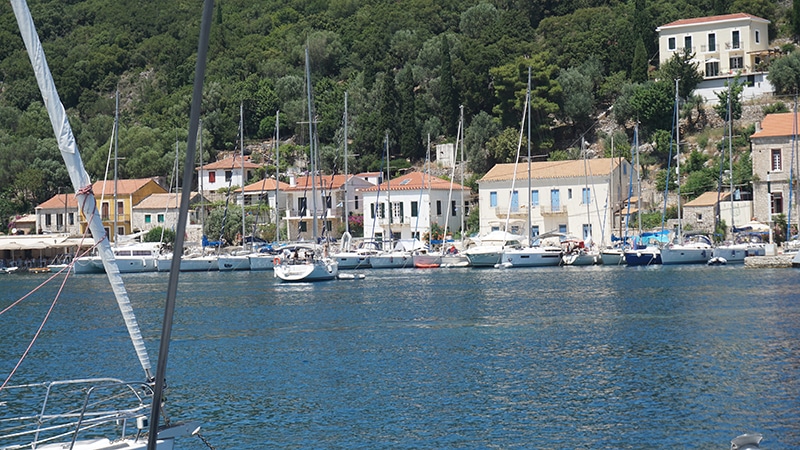
This is where the rubber meets the road—or, in this case, where the gel coat does not touch the big bad hard concrete wall.
A “Mediterranean Mooring” is so-called because in almost every Mediterranean marina the port authority requires you to perform one. You cannot go side-to at the dock. Side-to takes up too much room per boat.
Once you master the skill of Mediterranean Mooring you will find all kinds of scenarios outside of the Mediterranean whereby you will want to and need to perform this maneuver.
 Lunch Time Entertainment
Lunch Time Entertainment
On the island of Saint Lucia in Marigot Bay, we wanted to have lunch at JJ’s Mangrove Restaurant but all the mooring balls in the bay were occupied. They have a nice dock to pull up to at the back of the bay near the mangroves. We Med-Moored to the dock, all the while everyone in the restaurant was looking on, probably hoping for some disastrous entertainment. We disappointed them by performing the maneuver flawlessly, whereby we received a standing ovation. If you go there, have the jerk chicken. Wow!
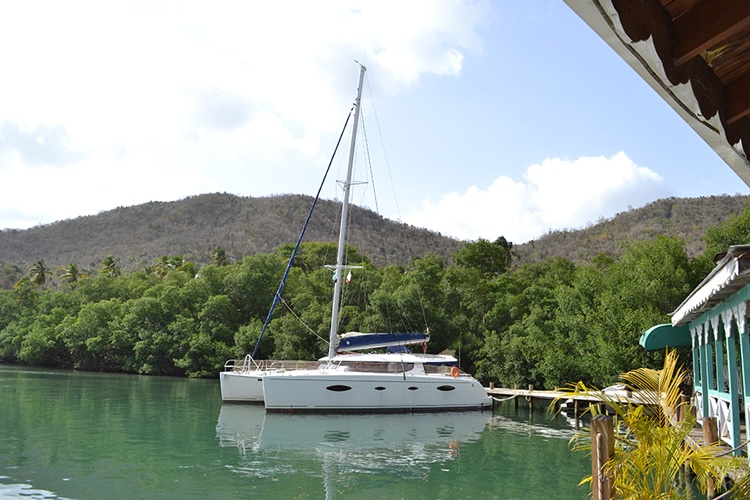
In a Mediterranean Mooring maneuver, you back up to the big hard concrete quay (pronounced key) and tie off your stern lines to the quay cleats. And since it is the Mediterranean, there is usually a $20 million boat owned by an Arab prince parked on either side of you, so it’s a good idea not to hit them. Also, in the Mediterranean, there are certain times of the year when there can be extremely high winds. All this calls for you to be an expert.
But don’t stress. With the new maneuvering and backing skills you are learning here and practicing, a Mediterranean Mooring will become simple and unintimidating. The first few times it is going to be boat and crew chaos, but not after you practice your newfound skills.
What makes Mediterranean Mooring fun and a must-learn skill is that after the chaos of getting situated, you get to sit in your cockpit with a good G&T, decompress, and watch the action on the quay—which is usually jammed with bars, restaurants, and passersby. Later, you can stroll along the quay and look into the cockpits of your $20 million neighbors and ponder the life of the rich and famous. It’s all good stuff.
The Two Types of Mediterranean Mooring to a Quay
There are two types of Mediterranean Mooring to a quay: The first has you reverse the boat up to the quay and simultaneously tie the stern of the boat to the quay while you haul up on a slimy bottom feeding line, the “slime line” and tie the slime lime to the bow of the boat. The second type is where you drop an anchor out in the waterway several boat lengths out depending on the depth. You then back up to the quay. Below we describe in detail both types.
Mediterranean Mooring With a Slime Line
A slime line is a line at the dock that runs down to the bottom of the seabed and out to a large concrete block called the Corpo Morto (dead body). You should use this method if a slime line is available.
The plan is pretty simple.
(1) Back up to the quay wall. The key lies in doing it all in one continuous swoop— not stopping short and then trying to restart your aftward motion. Especially in a monohull, if you stop short, your prop walk and the wind will really mess you around. You’ll have no water over the rudder and no steerage. Trying to straighten her up and back in again will not work. You’ll be better off completely starting again from a distance. If you are well-versed in backing now, this will be easy.
(2) Secure the aft dock lines and then put the boat in very slow forward gear. Then grab the slime line off the quay wall with a boat hook. For a catamaran, since you take up wo slips there will be two slime lines assigned to you. First, take the windward slime line.
(3) Walk the slime line forward. (Yuk! Now you know why it is called a slime line).
(4) Pull tight on the slime line to pull the boat out away from the quay wall. Cleat the slime line to the forward boat cleat. For a catamaran, repeat this for the leeward side of the boat.
(5) Put the boat in reverse gear with good throttle to use the boat engines to tighten the slime line and bring the aft closer to the quay wall. Adjust all lines as necessary.
(6) Those handling the slime line – wash hands!
The key to docking to a quay is preparedness and crew communication.
Preparedness: Preparedness prevents failure.
- Have the aft dock lines of proper length, cleated to the aft cleats, coiled, and ready to toss.
- Make sure that the dock lines are set on the appropriate side of the lifelines or stern rail to toss so that they do not get wrapped around on the wrong side.
- Have fenders placed.
- Have a competent crew assigned to specific jobs.
- Ensure the crew members know how to toss a line.
- Ensure crewmembers know how to tie a cleat hitch or any decent knot.
Communication: Communicate the plan.
- Warning – there is always an annoying person on the quay issuing instructions to your crew members. Prepare the crew to not take orders from those people.
- Instruct the crew exactly which quay cleat to toss and tie the aft dock lines.
The most common fails:
- As a new crew member, it is hard to understand that the slime line must be pulled in the direction from the Corpo Morto not from the quay. You have to specifically show the crew member assigned exactly what to do and which way the line must be pulled.
- Aft dock lines are often tossed on the wrong side of the stern rails or lifelines.
- Poor line-tossing skills
Success looks like this
Here is an image of the slime line cleated to the bow cleat and running forward taught to the Corpo Morto or mooring block.
Maintain Control
As the skipper, you have to maintain control of the boat but also the crew. For sure, people on the dock including marina staff will want to tell your crew what to do and when to throw lines, etc. Train your crew prior to docking to take instructions from you only, or else everything gets out of sync.
Here is a video we shot in Cannigione in Sardina after a challenging time with the dock crew. Fortunately, my crew listened to me and we did a successful docking. At the start of the video, I also talk about the slime line.

